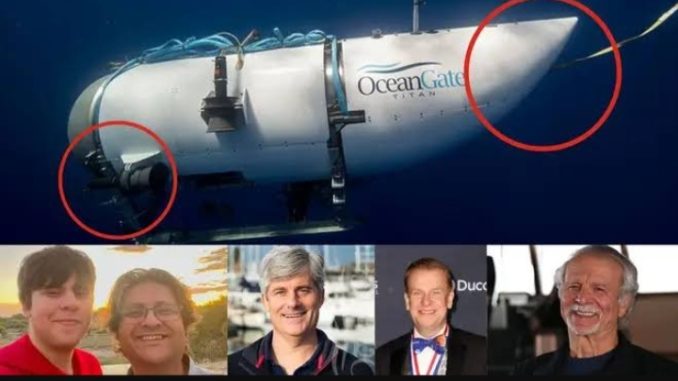
All five passengers aboard a submersible that vanished while on a dive to explore the Titanic wreck site have died, officials said Thursday after underwater robots discovered seafloor debris from the sub that was “consistent with a catastrophic implosion.”
A robot from the Canadian vessel Horizon Arctic discovered several major pieces of the 21-foot sub, the Titan, in a debris field about 1,600 feet from the bow of the Titanic, U.S. Coast Guard Rear Adm. John W. Mauger said at a news conference.
The debris is consistent with the catastrophic loss of the pressure chamber,” Mauger said.
Debris from Titan submersible found near Titanic wreckage
The tail cone of the submarine was found Thursday about 1,600 feet from the bow of the Titanic.
The families of the passengers have been notified, he said.
“On behalf of the U.S. Coast Guard and the entire unified command, I offer my deepest condolences to the families,” he said. “I can only imagine what this has been like for them. I hope that this discovery provides some solace during this difficult time.”
The five passengers were Stockton Rush, the pilot of the exploration and chief executive of OceanGate Expeditions, which owns and operates the sub; Hamish Harding, chairman of Action Aviation, a Dubai-based aircraft dealer; Paul-Henry Nargeolet, a veteran and accomplished diver with more than 30 trips to the wreck site; and Pakistani businessman Shahzada Dawood and son Suleman.
OceanGate said in a statement that its “hearts are with these five souls and every member of their families during this tragic time.”
These men were true explorers who shared a distinct spirit of adventure and a deep passion for exploring and protecting the world’s ocean,” the company said. “We grieve the loss of life and joy they brought to everyone they knew.”
The sub was reported missing after it lost contact with the Canadian research vessel Polar Prince about 1 hour and 45 minutes into its dive Sunday about 900 miles east of Cape Cod, Mass., the Coast Guard said.
Its disappearance set off an international search-and-rescue effort, as crews raced around-the-clock using specialized equipment to find the sub, which was designed to have an initial air supply of 96 hours. Officials also said it had only “limited rations” of food and water.
The search grew to 10,000 square miles, roughly the size of Massachusetts, and went 2½ miles deep. Through the days-long effort, officials maintained optimism that the operation would remain a search-and-rescue effort and not a recovery mission.
Assets launched in the search included American and Canadian aerial support vessels that scanned the ocean’s surface and subsurface using sonobuoys; U.S. Navy divers; coast guard and research vessels from Canada, France and Norway, some of which were equipped with highly specialized remote-operated vehicles that could work on the ocean’s floor; and assistance from commercial vessels.
A moment of promise came Tuesday when the Coast Guard confirmed reports that banging noises were detected on the seafloor by sonobuoys dropped from Canadian aircraft. Although officials said the origins of the sounds were unclear, they became the target of search efforts.
